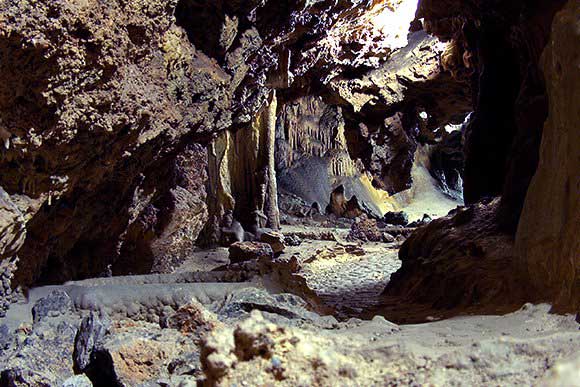
The cave of Agia Sophia in Mylopotamos
The cave of Agia Sofia of Mylopotamos is one of three caves with the same name in Kythira. The other two are located in Agia Pelagia and Kalamos. The name of the cave is a reference to the worship of Agia Sofia Martyros. According to a different story, the caves with this name were dedicated to God’s Wisdom (Sofia) (like the Haggia Sophia in Constantinople) and with time, this name came to be recognized as that of the Saint of the Orthodox Church. It is on the western coast, in the Kokkala port, 60 meters above sea level. It was famous from the 18th century, according to foreign travelers but until 1930 no research was conducted. The famous Kitherian spelaeologist Ioannis Petrocheilos, a teacher of physics in the Kythira Gymnasium, explored the cave and published writings about it. In 1955, after the death of Ioannis Petrocheilos, the cave was again explored by his wife Anna. A detailed study was then published. In 1970, in memory of her husband, she decided to make the cave of Agia Sofia a tourist site, map it in detail and rewrite the previous study. The cave is not fully arranged and still bears its natural characteristics. The adornment of the cave of Agia Sofia immediately catches the visitor’s eye. It has impressive natural black, white, and red, colors, which are a result of the rock evolution in the cave. Its rooms are generally spacy and in certain cases, their height reaches seven meters. This allows visitors to feel at ease since there is no lack of air or space.
The antechamber of the cave is decorated with a winged altarpiece with important 13th century hagiographies.There is also a small inscription stating that the hagiographies were created by a painter of that time called Theodoros. On the left of the entrance we can see Agios Panteleimon and then four paintings of Sophia and her daughters Agapi, Elpida and Pisti. On the left side of the gate we can see Saint Nicholas. On the right side we can see the Archangel Michael. On the right of the entrance we can see a praying stand with Jesus Christ on a throne, with the Virgin Mary and John on his side. Left of the stand, we can see Saint Theodoros Kinthiras (of Kithera). To the right we see Saint Theodosios the Koinoviarchis, wearing a white hood.
The cave harbors a chapel of Saint Sophia built later (1875) where a mass is held each year on September 17th. Across the chapel there is a small natural lake, which was used as baptismal font for children with health problems.
The cave is considered as one of the most active in Kythira. Stalagtites and stalagmites are constantly formed. Their growth has however decreased recently due to reduced rainfall in the area. A rare endemic species of isopod, Kythironiscus Paragamiani, is part of the cave’s fauna. It was discovered by Kaloust Paragamian, a member of the Hellenic Speleological Society and of the Hellenic Institute of Speleological Research.
MAIN CHARACTERISTICS OF THE CAVE: The cave extends from west to east in a straight line with a length of 110 meters. The tourist trail: 220m. (total 500m.) Elevation: 60m above sea level Direction: west – east Maximum depth: 1,5m. Maximum height: 6m. Area: 2.200 sq.m. Temperature:18 C Humidity: 64%

Leave your comment
You must be logged in to post a comment.